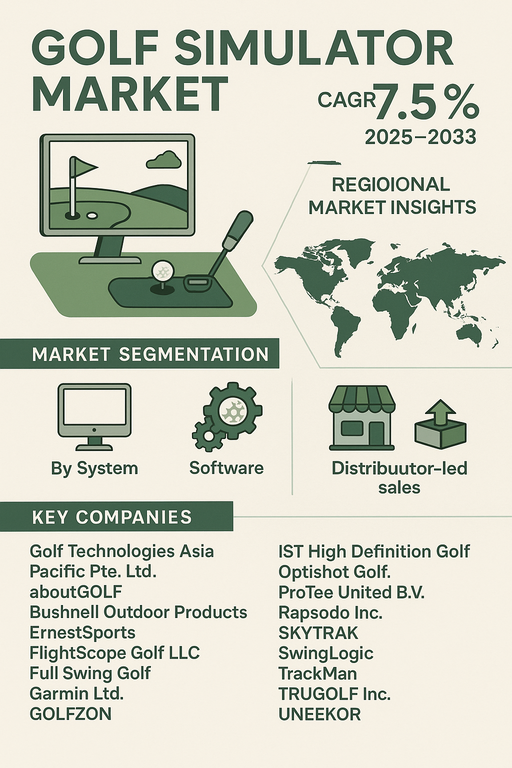The global golf simulator market is projected to expand at a CAGR of 7.5% from 2025 to 2033, driven by increasing interest in indoor sports, rising adoption of virtual training technologies, and the growing popularity of golf as a leisure and professional sport. Golf simulators offer immersive experiences that replicate real-world courses, enabling players to practice and play regardless of weather conditions or geographic limitations. The convergence of advanced hardware and software technologies is enhancing realism, interactivity, and data analytics, further fueling market growth.

Advancements in System Technologies
The market is segmented into hardware and software systems. Hardware encompasses sensors, launch monitors, projectors, hitting mats, and simulators’ structural frameworks that provide precise measurement of swing dynamics, ball trajectory, and impact analysis. Continuous innovation in sensor accuracy, motion capture, and high-definition graphics has elevated the realism of simulated play, attracting both amateurs and professional golfers. Software platforms complement these systems by offering virtual course simulations, real-time analytics, and interactive training modules. Integration with mobile applications, cloud-based scoring, and multiplayer features is enhancing user engagement, allowing golfers to track performance metrics and compete globally.
Distribution Channels and Market Penetration
Golf simulators are primarily distributed through direct sales and distributor-led channels. Direct sales involve manufacturers selling simulation systems directly to consumers, golf academies, sports clubs, and entertainment venues, enabling customization and direct after-sales support. Distributor-led sales expand market reach, particularly in regions where local partnerships and service networks are essential for installation, maintenance, and technical support. The dual-channel approach ensures that simulators are accessible to diverse customer segments, from individual enthusiasts to commercial establishments and training centers.
Market Segmentation by System
The golf simulator market is divided into hardware and software systems. Hardware forms the backbone of simulators, comprising sensors, launch monitors, projectors, hitting mats, and structural frameworks that accurately capture ball trajectory, swing dynamics, and impact measurements. Continuous innovation in high-speed cameras, motion capture, and launch sensors has enhanced realism and precision, allowing golfers to replicate on-course performance. Software systems complement hardware by offering virtual course simulations, performance tracking, scoring analytics, and multiplayer experiences. Cloud-based platforms and mobile app integrations are increasingly being deployed, enabling golfers to track performance over time and compete remotely with peers. The synergy of hardware and software is pivotal to market growth, as it determines the overall accuracy, interactivity, and immersive quality of simulator experiences.
Market Segmentation by Distribution Channel
Distribution channels for golf simulators include direct sales and distributor-led sales. Direct sales provide manufacturers with the opportunity to sell systems directly to end-users, including sports clubs, entertainment centers, and individual consumers, allowing customization, seamless installation, and direct after-sales support. Distributor-led sales expand market penetration in regions where local expertise is critical for setup, maintenance, and technical service. These distributors often partner with regional sports retailers or technology integrators to offer bundled packages, ensuring that simulators are accessible to both urban and emerging markets. This dual distribution approach enables market players to cater to a wide range of customer segments while addressing logistical and service challenges efficiently
Regional Market Insights
North America represents a significant share of the golf simulator market, supported by the widespread popularity of golf, high disposable income, and a strong recreational sports infrastructure. Europe follows closely, driven by active participation in indoor sports and the adoption of advanced simulation technologies. The Asia-Pacific region is experiencing rapid growth, particularly in countries such as Japan, China, and South Korea, due to increasing leisure activities, technological adoption, and growing interest in golf among younger demographics. Emerging markets in Latin America and the Middle East are gradually adopting simulators as investments in sports and entertainment infrastructure expand.
Competitive Landscape
The competitive landscape is marked by a mix of established global manufacturers and region-specific innovators. Leading hardware providers such as Golf Technologies Asia Pacific Pte. Ltd., aboutGOLF, Bushnell Outdoor Products, and ErnestSports focus on precision sensors, launch monitors, and high-fidelity simulation systems. Companies like FlightScope Golf LLC, Full Swing Golf, Garmin Ltd., and GOLFZON offer integrated hardware-software solutions that enhance performance tracking and interactive experiences. Specialist simulation providers including IST High Definition Golf, Optishot Golf, ProTee United B.V., Rapsodo Inc., SKYTRAK, SwingLogic, TrackMan, TRUGOLF Inc., and UNEEKOR focus on realistic gameplay, cloud analytics, and innovative software platforms tailored for both commercial and consumer markets. Market competitiveness is driven by technology differentiation, accuracy, immersive experience, and post-sales support.
Historical & Forecast Period
This study report represents analysis of each segment from 2023 to 2033 considering 2024 as the base year. Compounded Annual Growth Rate (CAGR) for each of the respective segments estimated for the forecast period of 2025 to 2033.
The current report comprises of quantitative market estimations for each micro market for every geographical region and qualitative market analysis such as micro and macro environment analysis, market trends, competitive intelligence, segment analysis, porters five force model, top winning strategies, top investment markets, emerging trends and technological analysis, case studies, strategic conclusions and recommendations and other key market insights.
Research Methodology
The complete research study was conducted in three phases, namely: secondary research, primary research, and expert panel review. key data point that enables the estimation of Golf Simulator market are as follows:
Market forecast was performed through proprietary software that analyzes various qualitative and quantitative factors. Growth rate and CAGR were estimated through intensive secondary and primary research. Data triangulation across various data points provides accuracy across various analyzed market segments in the report. Application of both top down and bottom-up approach for validation of market estimation assures logical, methodical and mathematical consistency of the quantitative data.
| ATTRIBUTE | DETAILS |
|---|---|
| Research Period | 2023-2033 |
| Base Year | 2024 |
| Forecast Period | 2025-2033 |
| Historical Year | 2023 |
| Unit | USD Million |
| Segmentation | |
System
| |
Distribution Channel
| |
End Use
| |
|
Region Segment (2023-2033; US$ Million)
|
Key questions answered in this report